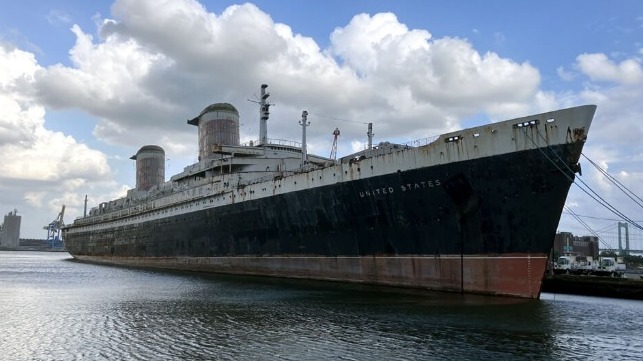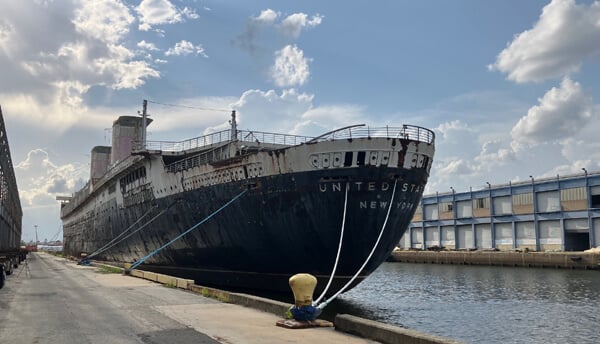Frustrations as Departure of Famed Ocean Liner SS United States Delayed

Excitement over the impending departure of the famed ocean liner ss United States was building last week before a further delay appeared prolonging her stay in Philadelphia. The new owners of the liner, Florida's Okaloosa County, have been trying for months to start the final voyage of the now 75-year-old liner as she heads toward a new chapter as the largest artificial reef.
On Wednesday, February 5, Okaloosa County announced that after months of delay, it had finally received all the necessary approvals for a large ship dead tow as defined by the U.S. Coast Guard. At high tide around 0600 on Thursday, February 6, the plan was to yank the 53,000 gross ton liner from Pier 82 where she has been docked since July 1986 after the vessel returned from having been stripped of her interior fittings in Turkey and Ukraine.
The ss United States despite having been out of service since 1969 remains fabled in the annals of shipping history. Design by American’s renowned naval architect William Francis Gibbs, she entered service in 1952. On her maiden voyage, she shattered the Atlantic speed record for a passenger liner with an average speed of over 35 knots and 72 years later remains the fastest passenger liner to have ever crossed the Atlantic. The liner is rumored to have touched 40 knots during her “top secret” speed trials.
The non-profit SS United States Conservancy, which acquired the ship in 2011 and sold her to Okaloosa County in October last year for $1 million, wrote in an announcement, “After completing comprehensive due diligence involving extensive testing and reporting to local, state, and federal agencies, Okaloosa County has now received final approval from the U.S. Coast Guard to begin moving the ss United States.”
The delays had centered on concerns from the U.S. Coast Guard to ensure a proper dead ship tow plan was in place for the nearly 1,000-foot liner. The review included safety precautions and planning for the tow as well as questions regarding the stability, appropriate amount of ballast, and the structural integrity of the vessel.
The first step of the complicated tow plan calls for a lateral move from the north side of Pier 82 to the south side of Pier 80. That would ensure she was floating freely, and final preparations would be completed for the next phase which starts her final trip with her next stop in Mobile, Alabama.

The liner's first move will be lateral from Pier 82 to Pier 80 before being moved into the Delaware River (Allan Jordan photo)
The departure from Philadelphia was scheduled for February 8, which in an odd quirk of fate is 75 years to the day from when her keel was laid in the dry dock at New Port News Shipbuilding and Dry Dock Company. Tugboats were to maneuver the ss United States from Pier 80 into the Delaware River at approximately 0330. She was due to proceed downriver during low tide at approximately 0430. Complicating the maneuver are the roadway bridges passing over the river (Walt Whitman Bridge (I-76), Commodore Barry Bridge (U.S. 322), and the Delaware Memorial Bridge (I-295) along her route. The Delaware River Port Authority (DRPA) has determined it will suspend traffic on the bridges as the liner passes underneath. On at least one of the bridges, the liner’s funnels and mast only have a few feet of clearance to the underside of the bridge. Near the mouth of the Delaware River, she will be secured to an ocean-going lead tug for the trip to Alabama.
First, it was announced that the lateral move was delayed to the second high tide of the day at approximately 2020 on Thursday, February 6. Then, during a last-minute meeting with the U.S. Coast Guard and others, further questions arose related to the towing of the vessel.
“Plans to move the ss United States from Philadelphia, Pennsylvania, to Mobile, Alabama, have been delayed due to follow-up details requested by the U.S. Coast Guard to ensure a proper tow from Pier 82 to Pier 80. Because of the delay of the pier transition, the departure tow out of Philadelphia originally planned for February 8 has been delayed. A new date has not been set for departure,” the Conservancy announced in a follow-up posting on social media.
The Conservancy added that it understands the frustrations brought about by the continuous delays of the vessel’s voyage and called for more patience. The delay is indefinite with no target date announced for the next attempt to move the liner.
Okaloosa County has estimated it will be a two-week journey for the liner to reach Mobile, Alabama. Upon arrival, the vessel will undergo an extensive remediation removing oil from her fuel tanks and other contaminants. Her iconic profile will be lost as her two massive funnels and her radar mast are to be dismantled and all the windows removed. There are also plans for unspecified modifications to ensure that when the vessel is deployed, it will land upright underwater. The preparation processes are anticipated to take about 12 months.
Okaloosa County highlights that the exact location along the Gulf Coast where the ss United States will be deployed as an artificial reef has not been set. It is expected to be about 20 nautical miles south of the Destin-Fort Walton Beach area.
“As the world’s largest artificial reef, the story of the ss United States will be told to thousands of divers from around the world as they explore her unique design and features. She will also benefit her surrounding ecosystem and become home to countless marine species that will thrive from the presence of her structure,” said Okaloosa County.
The County added that due to her size and the depth, the vessel will be home to a wide variety of marine life from iconic reef fish such as red snapper to pelagic species of fish like wahoo. The County is also helping the Conservancy with plans to establish an on-shore visitor’s center and museum dedicated to the liner and American design.
